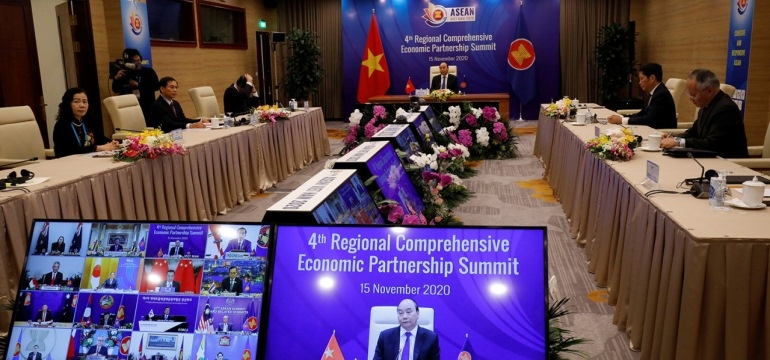The Asia-Pacific region has the world's largest free trade zone

China signed the largest agreement in the world free trade zone from 14 Asia-Pacific countries with a population of 2.2 billion people. The document, which was signed on 15 November during the virtual summit of the countries of South-East Asian Nations (Asean) in Hanoi (Vietnam) provides for the reduction of tariffs and establishment of common trade rules for all participants. The agreements concern the sphere of trade, services, investment, electronic Commerce, telecommunications and copyright.
the Agreement on "Regional comprehensive economic partnership (RCEP) was signed by China, Vietnam, Singapore, Indonesia, Malaysia, Thailand, Philippines, Myanmar, Brunei, Laos, Cambodia, Japan, Australia, South Korea and New Zealand. These countries provide about one-third of global production.
To coronaviruses caused by the crisis, the share of the RCEP countries in total world trade volume accounted for 29% (compared to 33% of the European Union), and after the signing of the agreement, it will continue to grow.
representative of the Australian strategic policy Institute Jeffrey Wilson stated that "RCEP will change the economic and strategic map of the Indo-Pacific region and will accelerate the economic recovery after the pandemic.
To discuss the agreement was held 18 meetings of Ministers and 31 rounds of negotiations and the signing date was postponed 6 times. The deal depended on India, which was opposed to certain points, but at the end of 2019 refused the negotiations opened the way for signing.
Now the world's trading superpowers – the US and the EU will have no impact on trade rules that will set the countries of Asia.
In 2015, the United States and 11 other countries signed an agreement on free trade zone between the Pacific countries, on which he worked 5 years. For US it became the main agreement since 1994, when it created the North American free trade area. However, D. trump after his victory in the US presidential election in 2016 decided to stop the partnership and to start a trade war with China.
Now the new President of the United States needs to resume cooperation with China, so since the new year we should expect new solutions regarding the situation that two years has a negative impact on the agricultural markets, in particular now – to the markets of soybeans and corn, which China has to buy in the United States after the signing of the first part of the bargain.


